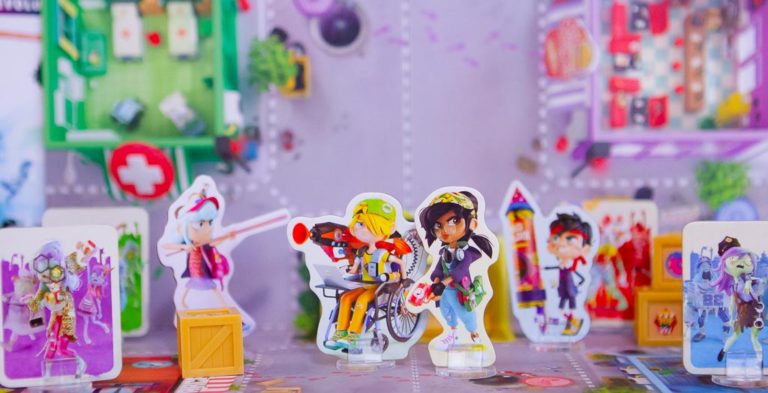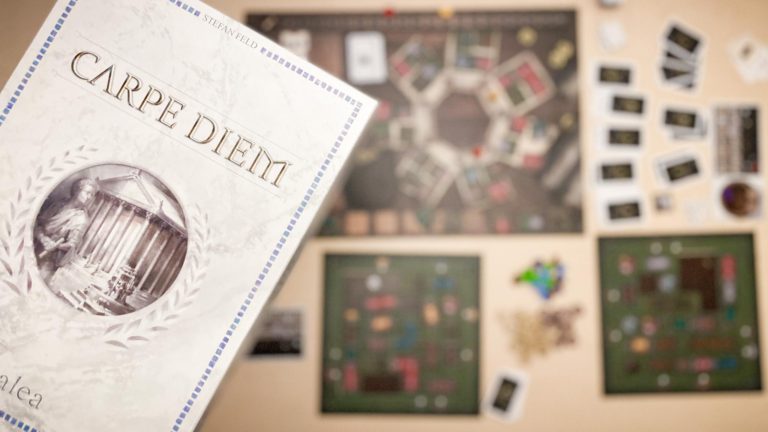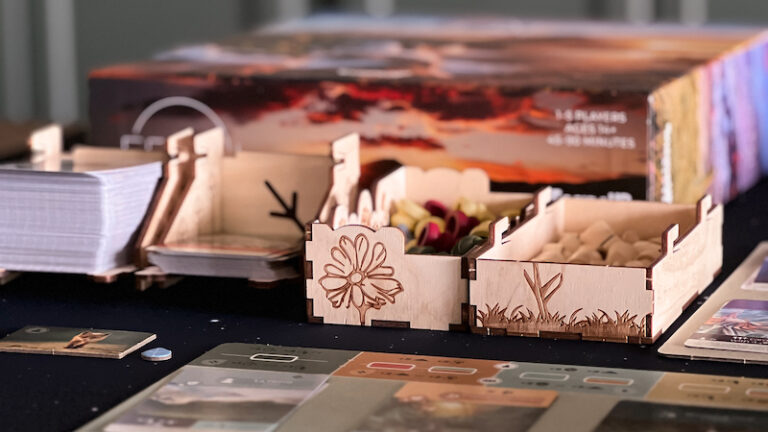Civilization games have always sounded fun to me.
The idea of developing and managing a society and needing to make moves that benefit that society in order to advance throughout the game appeals to me greatly. I’m a huge fan of city building games, so civilization games seemed right up my alley.
But they always have a pretty lengthy time commitment. And as parents to five young kids, we don’t have many opportunities to sit down for games that exceed three hours.
Which is why I was so excited when Stonemaier Games announced Tapestry!
What is Tapestry?
Tapestry is a medium weight, asymmetrical civilization game for 1 to 5 players where you will take your civilization from the beginning of human kind into the future over the course of around 2 hours.
At first blush, Tapestry can look pretty daunting.

It’s got a big map board, a bunch of tiles, four action selection tracks, a host of unique cards and civilizations, player mats, and a whole lot of miniatures. I’d be lying if I said that you wouldn’t need some time to learn every in and out of this game.
However! I am happy to tell you that Tapestry is actually a pretty straight forward game.
I have a lot that I want to discuss about Tapestry. And since you read a review to get to the actual review, I’m going to skip going over every bit of the rules so that I can share with you what I love about this game. If you want to know exactly how to play Tapestry, I highly recommend checking out Rodney Smith’s Watch It Played Youtube video.
Today I’m just going to try to break it down to it’s bones enough so you can have a general idea of what you’ll do in the game.
Gameplay Overview:
During set up, players choose one of the 16 civilizations that will give them some sort of unique ability they are able to use during the game or after it has finished.
Once set up, there are only two types of turns you can take: Advancement, and Income.
Each turn you much choose whether and how to use your resources to advance along one of the four advancement tracks, (science, technology, military, exploration) or take an income turn. If you advance, then you spend the resources, advancing one space ahead and gain the benefit on your chosen track. These benefits get progressively better the further you advance. If you do not have enough resources left to advance or you choose not to use them, then you take an income turn which enters you into a new era of your civilization, earning you more resources from the exposed income tiles you revealed during the game thus far on your income mat.
Play goes in turn order around and around the table until everyone has taken their fifth and final income turn. Players can finish the game at different times.
After the last person has taken their final income turn the person with the highest score is the winner.
What do we think?
I’m not going to bury the lead here. I truly enjoy playing Tapestry and am so happy that we purchased it. This is a game that I can see us playing for a long time.
I didn’t think that at first though.
After our first play of Tapestry, I thought, “eh, this is nice, but…I’m not so sure it’s going to be a top game for me.” Then we played it again, and again, and again, and with each play my enjoyment and satisfaction with the game grew. Tapestry is one where you can’t play it once and become an expert on strategy or even feel like you know exactly what you should have done. It takes a while and a few plays to really see how to use all of the different tracks, resources, and cards to achieve your goals.
Unlike other games though, I wasn’t turned off by the array of choices provided in Tapestry.
If you’ve ever played A Feast for Odin, you know what a game with lots of choices can do to the brain. After my first play of that game I wasn’t itching to come back for more. Looking at that huge buffet of options was frustrating and overwhelming; I just didn’t know where to start. This was the feeling I was most nervous about having during Tapestry.
But I never did! And here’s why:
At most, the number of choices you will have to choose from are five. Yes, there are a lot of choices that you need to consider for the entirety of the game, but on a given turn, there are only five things that you can choose to do: one thing from each of the four advancement tracks or take an income turn. So while there are 48 action spaces on the board, only four of them are available to you to choose from at a given time!

Now, Tapestry can still lead to some intense feelings of analysis paralysis, but the more you play, the easier this will get as you can better see which options benefit you the most at a given time and which ones you need to work towards for later in the game.
That being said, don’t spend a huge chunk of time plotting out every single last move you are going to make. Tapestry is a bit more fluid and you need to adapt your strategy to changes in the game, (probably a lot like any civilization needs to adapt and change course over time.)
There is some luck involved in the Tapestry card draws, or the technologies available, so if one doesn’t suit your game, you’ll either have to figure out a way to get a different one, or find a way to make it work and adapt. Overall though, the luck element is relatively minimal and feels thematic when it occurs.
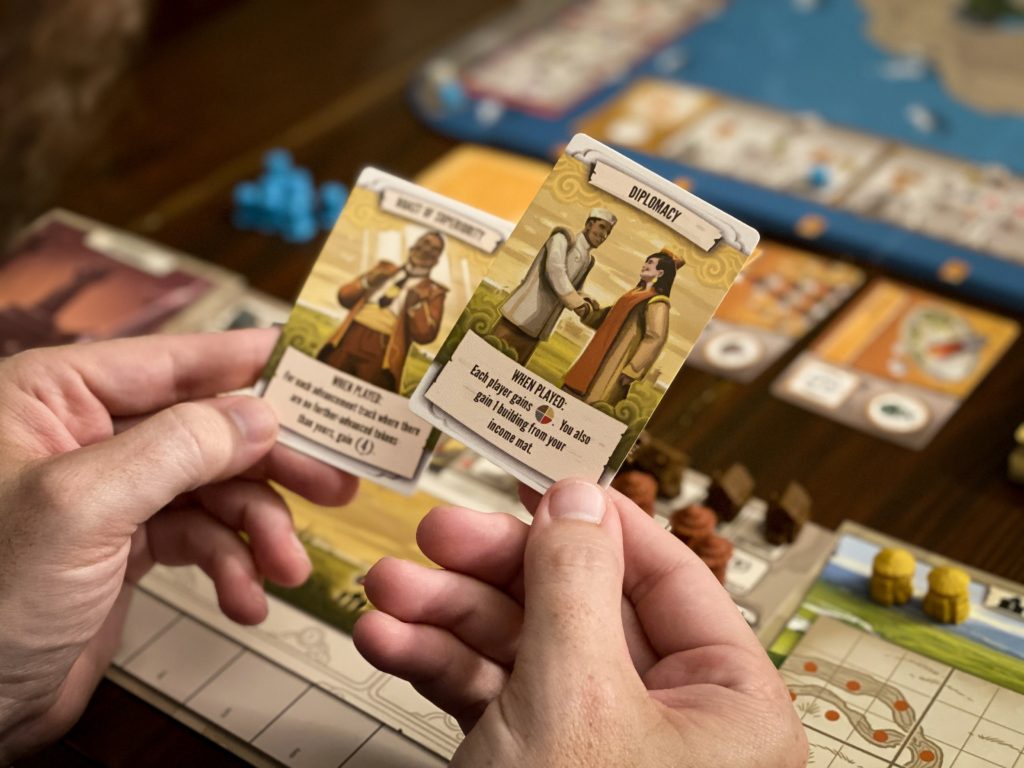
Asymmetry
I have to tell you about my favorite thing in Tapestry: the civilizations! The civilizations are all asymmetrical, giving players unique goals and ways to acquire resources, victory points, or other benefits throughout the game. Each game we have played we have made it a point to use a unique civilization to see how they stack up and each has done a fantastic job of making every experience feel unique and original.
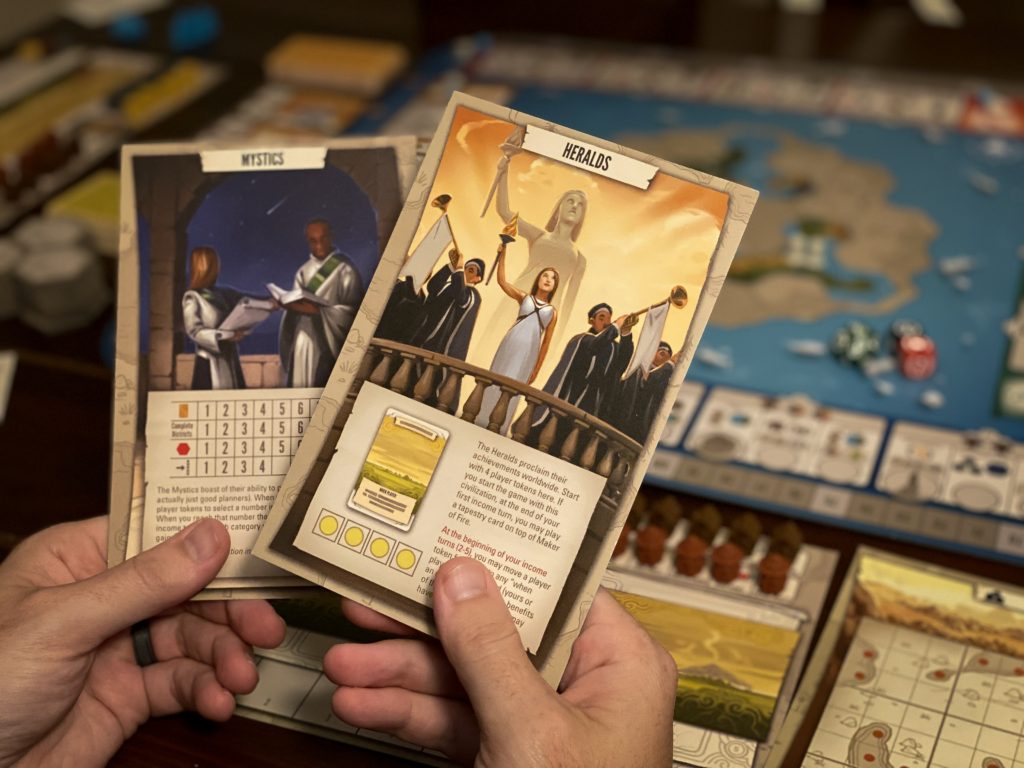
Many games boast a “multiple paths to victory” ability when there’s really only one or two great ways to get there with players just taking those well worn paths game after game. The asymmetry provided by the civilizations is just fantastic and forces me to get out of my comfort zone and try new strategies. Each game we have played I feel like the winner has taken a different course to get there. It has kept every single game exciting for me and gives me the itch to play again and again to see if I can improve on my score with the same civilization.
That combined with the amount of technology cards, capitol city maps, and the fellow players having their own civilization and goals that require you to adjust your strategy truly means each game will be different every time you play.
This high level of replayability will keep Tapestry a regular at our table.
Theme
The theme of building a civilization in Tapestry really comes through for me. It’s more of a pulled back, “view from above” theme rather than getting into the nitty gritty of every aspect of building a civilization, but it still comes through.
It does require a bit more of your imagination though. The first few plays I didn’t really think the theme came across. I was too focused on trying to figure out how and when to use each advancement track and how to milk every last possible point potential out of my resources.
Later on, as I got more comfortable with the mechanics, the theme started to show itself more vibrantly. And it takes a really fun turn too. It reminds me of Euphoria (also from Stonemaier Games) and the cheeky humor it had plays very well in Tapestry.
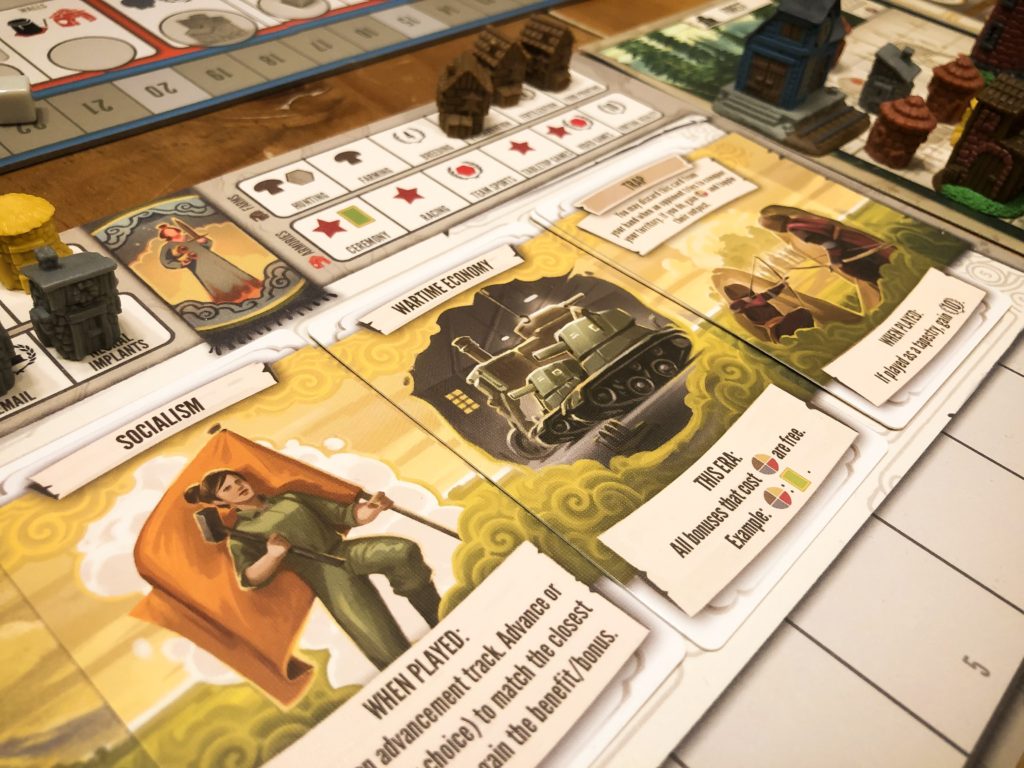
The storytelling present in Tapestry sets up the potential for some really memorable game nights. For instance, in one of my favorite games we played, Adam was the Militarists and wanted to advance along the military track. I needed to do so as well and just happened to have the “Marriage of State” Tapestry card which allowed me gain the benefit on a specific track when my opponent did so, allowing me to focus on another track while he did all the work for me on military. This worked perfectly for my plan, but he wasn’t a fan of helping me out as he advanced himself. So fussy, my husband. So you can imagine his delight when I entered the next era…only to play the “Broker of Peace” Tapestry card, meaning that each time he advanced on the military track I would gain 3 victory points. HA! What luck! If the union between our civilizations was a bit rocky in the first era, so too were the peace negotiations of the second!
This is the kind of storytelling that I love. It’s just all so fun and does a great job of brining players into the game and not just focusing on the mechanics. Watching the story of your civilization grow and change and how they all intertwine together is a fun experience.
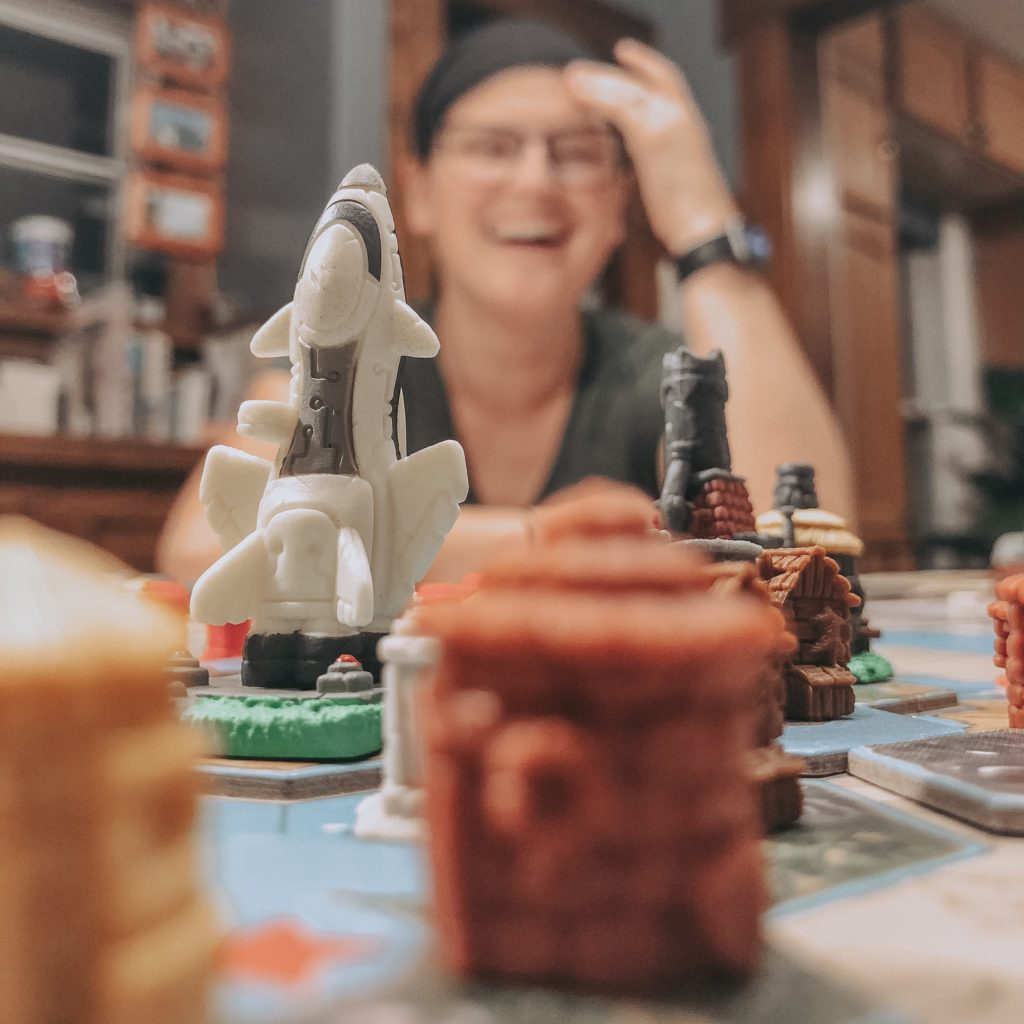
Components
In true Stonemaier fashion, Tapestry is packed full of beautiful components.
The art is done by Andrew Bosley who truly created a beautiful world. The detail on every card, mat, and tile is spectacular. The color scheme feels soft and muted in a really pleasing way. It’s not overly saturated and feels both timeless and unique.
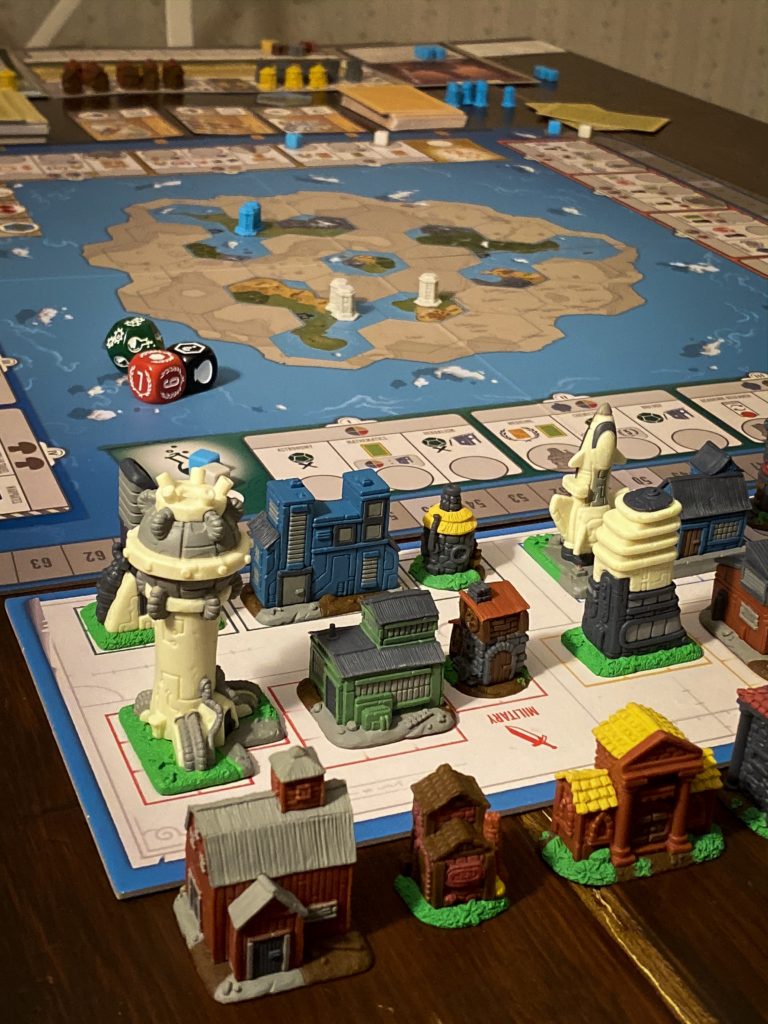
The miniatures included, designed by Rom Brown, are such a fun inviting design. We spent a good deal of time picking each one up and looking them over. They too are packed full of detail. My favorite pieces, perhaps surprisingly, are the small income buildings each player gets. These little huts are perfectly sized and have a really nice weight to them when held. Despite their size, there is so much character sculpted into them and using them is a delight.
I only had one mild frustration with the bases of the large sculptures. This might perhaps be a bit nit-picky, but we both found that the bases were just a tad small for the spaces they were required to cover on the capital city mats. The more organic design of the sculpts is beautiful, but does make it a tad difficult to tell if it is say a 2×3 or a 2×4 base. Even after many plays I still find myself having to double check the monument mat to see how many squares a building takes up and if you’re not careful, it can be easy to overlook a row or column that is actually filled, scoring you points, because a building doesn’t fill the squares fully.
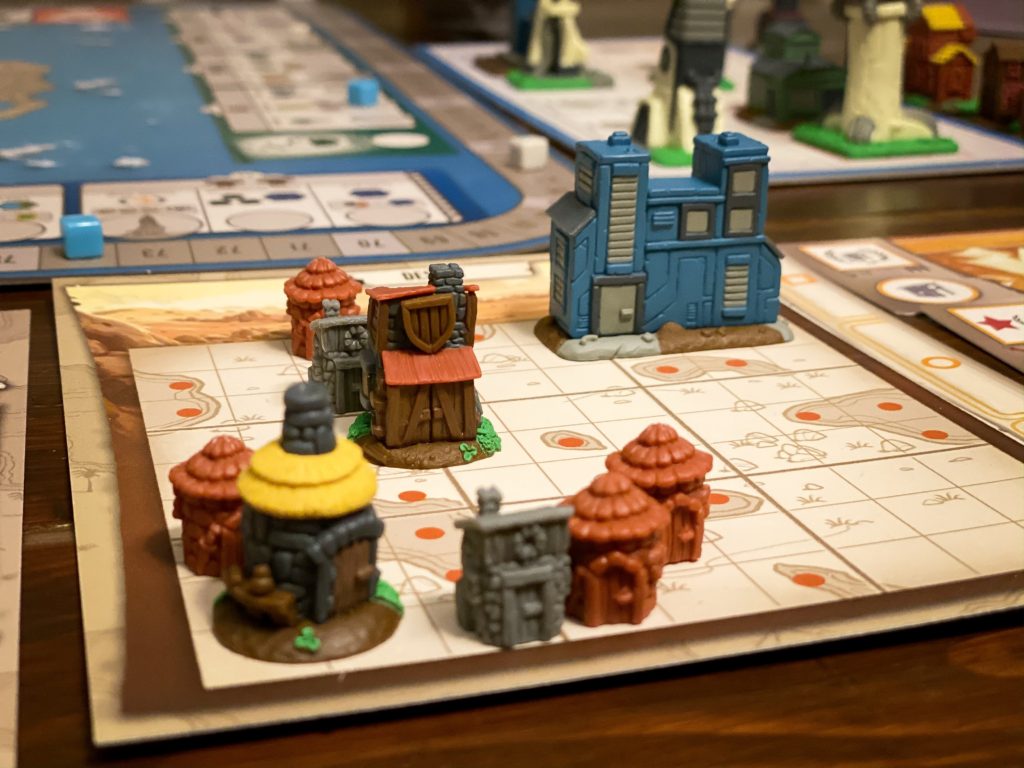
It’s funny; what drew me to wanting to purchase Tapestry was the beautiful Landmark Buildings, however, after playing, really the only “bummer” I felt was that the Landmarks weren’t more of a central aspect to the game. They sit off to the side of the main board on their own mat, then they come and sit in your capital city where they may or may not be helpful. (Notable exception, the Nomad Civilization does allow you to place buildings on the map. Probably why it is my current favorite to use.)
I’ve earned a lot of landmark buildings that I just couldn’t play in any meaningful way on my mat because they were too big to fit in around all of the impassible spaces. They are able to hang off your capital city, but that area of the landmark will not count towards anything. The one thing I wish is that there was some added benefit to having them more than them just taking up space on your capital city mat.
I have really enjoyed the slightly rough top layer that has been added to the player boards. This helps all of these miniatures to sit nicely and not slide around unnecessarily during play. I’m not sure if it can scratch off or how it will wear over time, but so far, I am very pleased with how it works.
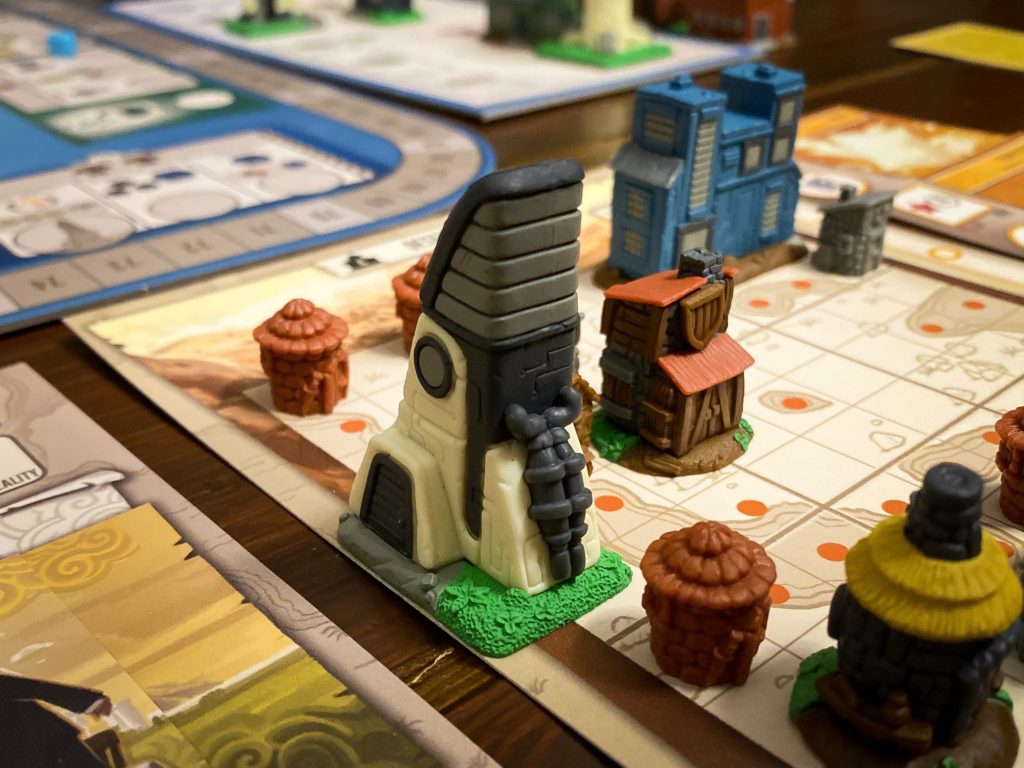
As beautiful as all of these components are, I was surprised that the insert included wasn’t of higher quality; while its functional, it isn’t the best. This is probably just me being spoiled by all of the Game Trayz inserts included in other Stonemaier games. It can be a little difficult to tell where the landmarks go in the insert. Luckily there is a picture on the side of the box that helps you know how to put everything away which is nice as I’d be lost without it. (okay, let’s be honest, Adam puts all the games away, not me.)
The rest of the pieces are all just bagged up. While I wish they had an official home in an insert, ultimately I don’t mind. There are plenty of bags included so you can bag up the game however you prefer.
How does it play with two?
We first and foremost bought Tapestry to be played with just the two of us.
That’s how it goes for most of our mid to heavy weight games in our house. These are our date-night games. We don’t go out very often so the money we don’t spend on dates we’ll occasionally use to splurge on a game like Tapestry. It’s a treat for just the two of us 99% of the time it hits the table.
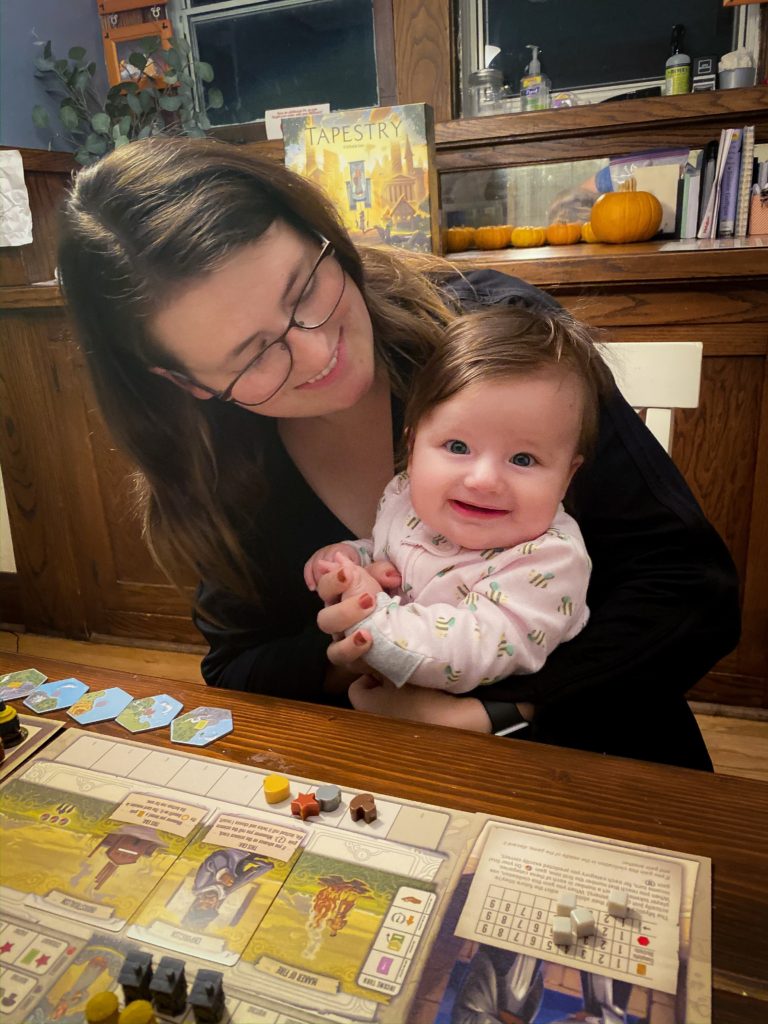
So if you’re like us, I’m happy to tell you that Tapestry plays very well with two players. So well in fact that this has become our number one choice for date night. This is mainly due to the wonderful unique feel brought on by the many civilizations.
But we’ve got five young kids who love to come up with all of the excuses to get out of bed at night so you know we’re crunched for time when it comes to game length. Each game we’ve played has taken about 90 to 120 minutes which is the sweet spot for me. We were even able to play two games back to back one night after the first finished quickly. (Quickly as in an hour, so not lighting fast, mind.)
For the most part, even at two players, we have still enjoyed a decent amount of player interaction as well.
There was one game where we pretty much left each other alone the whole time. This led to more of a solitaire feeling of the game that was still highly enjoyable. But then there was another where our civilizations, combined with our Tapestry cards, kept finding us butting up against one another which created a truly very fun back and forth.
There isn’t anything in the game that allows a player to do anything too negative to another player. This is a HUGE plus for me. It’s never fun for a game to feel mean and I think the potential for players to do something in Tapestry that really upsets someone else is very low. No date-night fights to worry about.
The only time we’ve run into issues where more people would have been beneficial has been with some of the technology cards since to upgrade those to their highest level you or someone to your left or right needs to be far enough along on a specific track to allow for the upgrade. (Most games this hasn’t been an issue.)
The more players you add, the more that time will fluctuate though. I’m not sure I would ever want to play it with the full five just because I don’t typically enjoy games that hit a 3 hour mark.
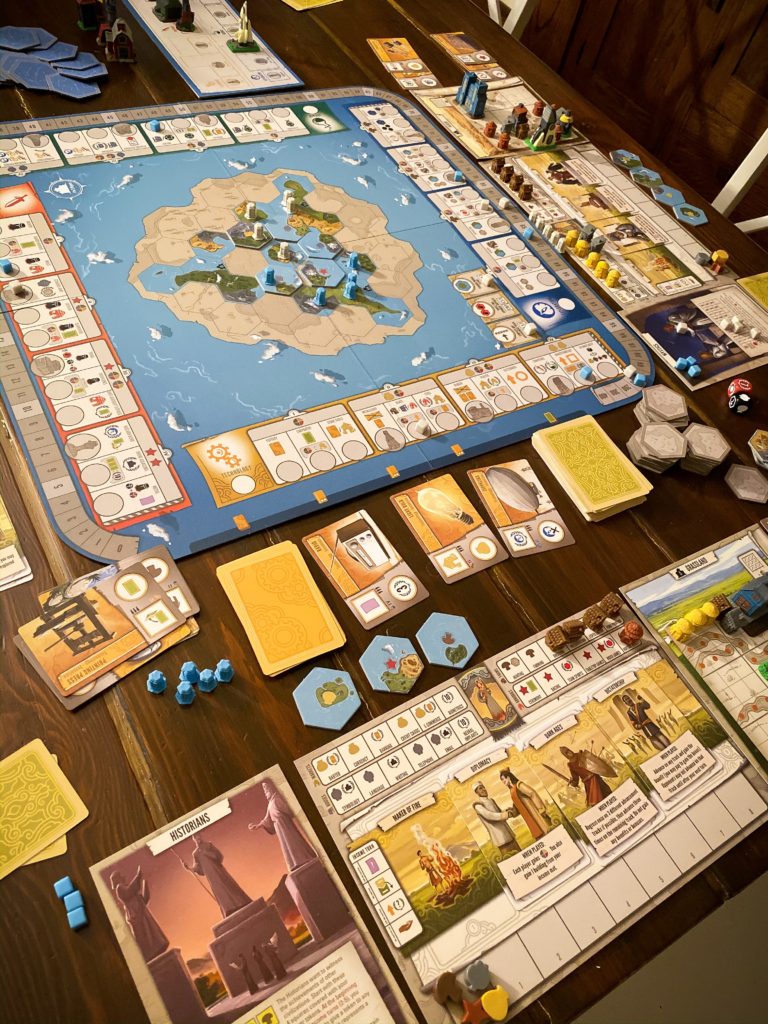
What were some of your questions?
On Instagram I asked if you had any questions for us on Tapestry. Here were some we received that I’d like to highlight!
Are the miniatures necessary?
I was asked this question the most.
While I’ve stated above my couple complaints about the landmarks themselves and it is true that this game could have been less costly if the miniatures would have been made a premium component rather than included in the game, I cannot tell you how happy I am that they come standard (and painted!!) in every Tapestry box. The feel would have been completely different if they were just polyomino pieces that you placed on your city map.
Are they perfect? No. Do they make the game cost more? Sure. But I think it’s worth it.
Is it really a civ game?
Everyone will have an opinion on this, but I truly think the feeling of building a civilization comes through in this game. If you really enjoy the long, drawn out, epic nature of other civilization games, you probably won’t find that itch scratched here, but that’s not what Tapestry is trying to be.
The more you play the more the feeling of building a civilization will come through.
Rather than waiting for someone to make it to the fourth section on the science track so that I can upgrade my technology card, I realize that I, or someone else needs to have discovered “Quantum Physics” so that I can use that knowledge to advance my civilization forward and upgrade my Radio to gain it’s highest benefit.
What I love so much about it is that I can enjoy the story of my civilization, meanwhile, across the table, Adam’s civilization is taking shape much differently; telling a completely different story. Both are unique, yet simultaneously connected with one another.
All of this while condensed into a manageable 2 hour (or frequently less) game that we can enjoy together without needing to schedule a babysitter.
Love. It.
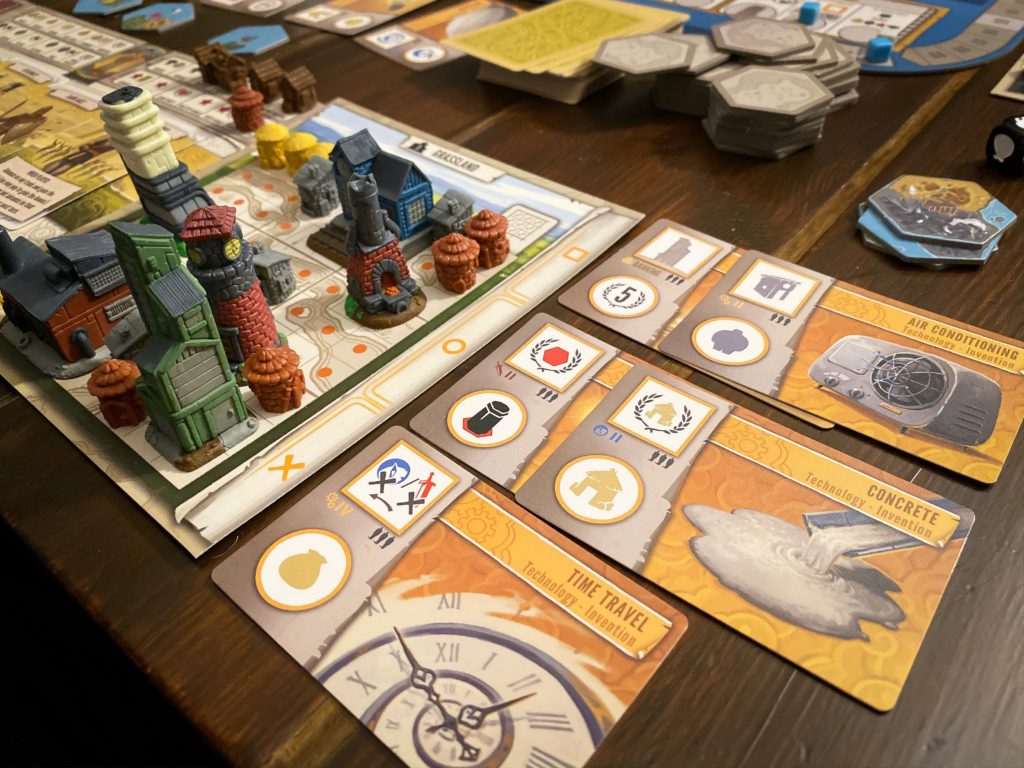
Are there large swings in the lead?
There can be! The thing that has been so interesting about our many games is that the way the scores take shape have all been relatively unique and dependent on your ability to navigate the board and how your civilization works. Some civilization cards score throughout the game while others give you a big end of game bonus if you completed certain objectives.
In some of our games, our scores were neck and neck the whole time. In other games, the person who looked out of it came back to win, in others…not so much.
There really is no “catch up” mechanic though if you are truly out of the game. If you are entering a new era first you do get some extra resources which I see as a way to help players who may be using up their resources quicker than others, (potentially not getting as many points during the era,) to have a few extra for the next era that can help them score some points.
But even if you have a bunch of resources, if you don’t use them wisely, you won’t be rewarded with points. I could see this being frustrating for some players.
Summary
If you are a fan of Stonemaier Games or enjoy asymmetrical gaming experiences I think you will highly enjoy Tapestry. This game has been worth every penny for us thus far and a really great treat to enjoy playing together in the evenings.
Tapestry is easy to learn, featuring an easily digestible rule book and some very helpful player aids that get you up and running quickly without spending hours going over the rules. Offering a wide variety of interesting choices to make game after game and the fantastic asymmetrical nature of the civilizations, Tapestry scores very high on our replayability scale as every game should feel fresh and unique.
While everyone may not connect with the theme, I find the storytelling present in Tapestry to be enjoyable and quirky and creates fun moments both during the game and after when you step back and look at the civilizations that were created. All of this condensed into a two hour time frame makes for a great gaming experience that we highly recommend!
If you would like to learn more about Tapestry or purchase your own copy, click here to visit the Stonemaier Games website. Or inquire at your friendly local game store to reserve a copy for your home before its November 1st release.
Game Info:
Title: Tapestry
1-5 players; ages 12+
Designer: Jamey Stegmaier
Artists: Andrew Bosley, Rom Brown
Publisher: Stonemaier Games
Published: 2019
*This post contains affiliate links at no cost to you. To read our full disclosure click here.*
If you enjoyed this review, you may also like:
10 of our Favorite Date Night Games
Wingspan
Euphoria: Build a Better Dystopia
Mangrovia



